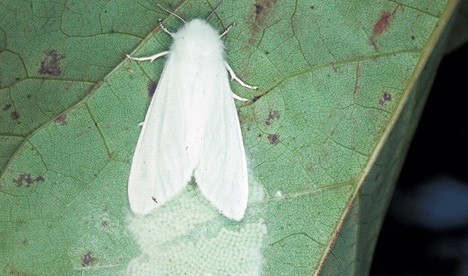Fall Webworm
The fall webworm, Hyphantria cunea (Drury) (Lepidoptera: Erebidae) is a polyphagous caterpillar pest of ornamentals and trees in Georgia. “Polyphagous” means that it can feed on many types of food, and the fall webworm is known to feed on more than 600 species of plants, including row crops, herbaceous plants, shrubs, fruit, and ornamental trees in orchards, nurseries, and landscapes. Fall webworm larvae construct silk web nesting to facilitate feeding, to escape the attack of natural enemies, and for heat retention. The webbing is considered unsightly, and feeding on foliage inside the nest leads to extensive defoliation. The fall webworm can quickly reduce the aesthetic appeal of landscape trees and shrubs, and severe infestation can cause considerable damage to trees.
The fall webworm is active during the summer and early fall. The white, hairy, female moth deposits approximately 600 eggs on the underside of leaves in masses covered with white hairs from her own body. The eggs hatch within a week, revealing red- or black-headed larvae covered with fine hair. Almost immediately, the larvae begin working together to construct a silken web over a branch tip, where they begin to feed. Initially, they skeletonize the leaves inside the web, but as the larvae develop, the webbing expands and covers more foliage on the tree branch. Larvae feed for up to six weeks until pupation. Mature caterpillars leave the web to pupate under bark crevices, soil, or stones. The pupal period may range from 12 to 80 days, depending on environmental conditions, followed by adult moth emergence. The fall webworm overwinters as pupa and can have multiple generations in a year.
Regularly inspecting trees and shrubs starting in midsummer will help detect infestations. Traps containing sex pheromones were developed to determine early flights. As part of a cultural control strategy, pruning infested branches will reduce extensive webbing. However, intensive pruning is not recommended, as it can reduce the productivity of fruit trees. Biological control plays a critical role in reducing fall webworm populations. Many beneficial arthropods, including spiders, insect predators, and parasitoids, are associated with the fall webworm. Vertebrate predators like birds and lizards will also feed on the caterpillars given the chance. Disrupting the protective webbing usually leads to death of all or most of the caterpillars inside, so any nests within reach of a long pole can be torn open as a control measure. As for chemical control, the microbial insecticide, Bacillus thuringiensis, is commercially available and can be used to manage fall webworm. Many synthetic insecticides are available, but spraying insecticides on a tree of any size is problematic and should only be attempted by trained professionals. Contact your county University of Georgia Cooperative Extension office for insecticide recommendations. If insecticides are used, always read and follow label instructions—it is the law.




